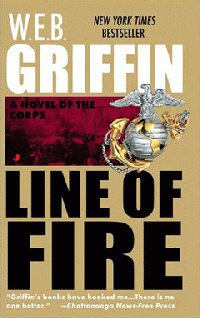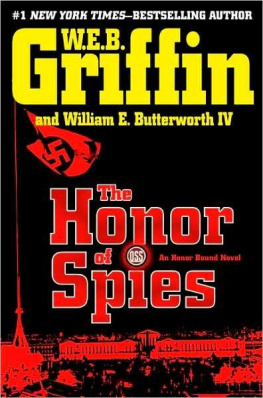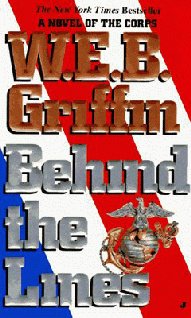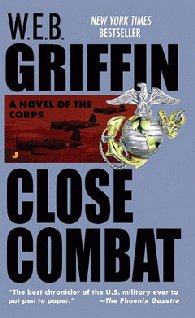W.E.B. Griffin - The Corps V - Line of Fire
Here you can read online W.E.B. Griffin - The Corps V - Line of Fire full text of the book (entire story) in english for free. Download pdf and epub, get meaning, cover and reviews about this ebook. genre: Prose. Description of the work, (preface) as well as reviews are available. Best literature library LitArk.com created for fans of good reading and offers a wide selection of genres:
Romance novel
Science fiction
Adventure
Detective
Science
History
Home and family
Prose
Art
Politics
Computer
Non-fiction
Religion
Business
Children
Humor
Choose a favorite category and find really read worthwhile books. Enjoy immersion in the world of imagination, feel the emotions of the characters or learn something new for yourself, make an fascinating discovery.
- Book:The Corps V - Line of Fire
- Author:
- Genre:
- Rating:4 / 5
- Favourites:Add to favourites
- Your mark:
- 80
- 1
- 2
- 3
- 4
- 5
The Corps V - Line of Fire: summary, description and annotation
We offer to read an annotation, description, summary or preface (depends on what the author of the book "The Corps V - Line of Fire" wrote himself). If you haven't found the necessary information about the book — write in the comments, we will try to find it.
The Corps V - Line of Fire — read online for free the complete book (whole text) full work
Below is the text of the book, divided by pages. System saving the place of the last page read, allows you to conveniently read the book "The Corps V - Line of Fire" online for free, without having to search again every time where you left off. Put a bookmark, and you can go to the page where you finished reading at any time.
Font size:
Interval:
Bookmark:

Griffin, W.E.B.
The Corps V - Line of Fire
THE CORPS is respectfully dedicated to the memory of Second Lieutenant Drew James Barrett, III, USMC Company K, 3d Battalion, 26th Marines Born Denver, Colorado, 3 January 1945 Died Quang Nam Province, Republic of Vietnam, 27 February 1969 and Major Alfred Lee Butler, III, USMC Headquarters 22nd Marine Amphibious Unit Born Washington, D.C, 4 September 1950 Died Beirut, Lebanon, 8 February 1984 "Semper Fi! And to the memory of Donald L. Schomp A marine fighter pilot who became a legendary U.S. Army Master Aviator RIP 9 April 1989
Chapter One
[One]
BUKA, SOLOMON ISLANDS
SPRING AND SUMMER 1942
In the early months of 1942, a Major of the U.S. Army Ordnance Corps in Australia was forced to reconsider his long-held belief that he'd passed the point where the Army could surprise him.
The Pacific and Far East Shipping Corporation's freighter John J. Rogers Jr. docked at Melbourne after a long and perilous voyage from Bremerton, Washington. In addition to desperately needed war material , it off-loaded 800 identical, sturdy wooden crates. Each of these was roughly three feet by three feet by four feet, weighed 320 pounds, and was strapped with steel, waterproofed, and otherwise prepared for a long sea voyage.
These crates were loaded aboard trucks and taken to the U.S. Army Melbourne Area Ordnance Depot, a requisitioned warehouse area on the outskirts of the city. Because they were in waterproof packaging and inside storage space was at a premium (and because the Ordnance Corps Major could not leave the shipping manifest), the crates were placed on palettes holding four of the crates-and stored outside under canvas tarpaulins.
It was two weeks before the Ordnance Corps Major could find time to locate the shipment, remove the tarpaulin, cut the metal strapping, pry open the crates, then tear off the heavy tar-paper wrapping.
He found (as the manifest said, and indeed as was neatly stenciled onto the crates in inch-high letters) that each of the crates did indeed contain US SABERS, CAVALRY MODEL OF 1912, W/SCABBARDS, 25 EACH.
The sabers and their scabbards were packed five to a layer, and each crate held five layers. It took him a moment to do the arithmetic: If he had 800 crates, and there were twenty-five cavalry sabers, with scabbards, in each crate, that meant he had 20,000 cavalry sabers, with scabbards. They all looked new; they had probably never been issued. The Ordnance Major was aware that the last horse-cavalry unit in the U.S. Army, the 26th, had been dismounted in the Philippines; their mounts were converted to rations for the starving troops on Bataan; and the cavalry men went off to fight their last battle as infantrymen.
On the face of it, cavalry sabers were as useless in modern warfare as teats on a boar hog. A lesser man than the Ordnance Corps Major would have simply pulled the tarpaulin back in place and tried to forget both the US SABERS, CAVALRY MODEL OF 1912, W/SCABBARDs and the goddamned moron who used up that valuable-as-gold shipping space sending them all the way to Australia.
But the Ordnance Major was not such a man.
He gave a good deal of thought to how he could make them useful, yet the best he could come up with was to convert them to some kind of fighting knives, perhaps like the trench knives of World War 1. On investigation, however, this proved to be impractical. The blades were too heavy and the hilts too awkward.
He'd just about concluded that the sturdy crates the goddamned sabers were packed in had more potential use to the war effort than the sabers, when he had another idea. This one seemed to make sense.
And so a contract was issued to an Australian firm (before the war it had made automobile and truck bumpers) to convert the sabers into Substitute Standard machetes-at a cost of U.S.
$2.75 each. The blades were cut down to sixteen inches and portions of the hilts were ground off. The scabbards, meanwhile, were run through a stamping press. In one operation the press cut the scabbard to size and sealed its end.
And so when First Lieutenant Joseph L. Howard, USMCR, Commanding Officer of Detachment A, USMC Special Detachment 14, decided he needed a dozen machetes for a military operation, he was given MACHETES, SUBSTITUTE STANDARD, W/SHEATHS which had begun their military careers as us SABERS, CAVALRY MODEL OF 1912, W/SCABBARDS.
Actually, he got more than a dozen. Lieutenant Howard had had previous experience with the U.S. Army Ordnance Corps (as a sergeant), and he'd learned then that he was lucky to get half or a quarter-of what he'd requested.
This request proved an exception to that rule. He requisitioned one hundred machetes, and he got one hundred MACHETES, SUBSTITUTE STANDARD, W/SHEATHS.
The mission Lieutenant Howard drew the machetes for involved a parachute drop of both personnel and equipment.
Since there were no specially designed cargo containers, or parachutes, available for the equipment (most importantly, shortwave radios), ordinary personnel parachutes had to be adapted.
Cushioning the radios against the shock of landing was rather simply accomplished by wrapping them securely in mattresses.
But that wasn't the only problem. The standard personnel parachute was designed for a standard soldier carrying normal equipment-that is to say, it could handle a "drop weight" of 200 to 225 pounds. The mattress-wrapped shortwave radios weighed approximately 110 pounds.
Since lightly loaded parachutes fall more slowly than heavier ones, and thus drift more, Howard's radios would not fall to earth anywhere near his personnel.
This was a matter of critical concern, because Lieutenant Howard intended to drop upon a small landing area in the mountains of Buka Island.
Approximately thirty miles long and no more than five miles wide, Buka is the northernmost island in the Solomons chain.
That places it just north of the much larger Bougainville and 146 nautical miles from the Japanese base at Rabaul on New Britain.
On Buka, there was a Japanese fighter base and a garrison of Japanese troops variously estimated from several hundred to several thousand.
There was additionally a detachment of the Royal Australian Navy's Coastwatcher Establishment. This consisted of one officer, Sub-Lieutenant Jakob Reeves, RAN Volunteer Reserve, and approximately fifty Other Ranks, all of whom had been recruited from the native population.
Sub-Lieutenant Reeves remained behind when the Japanese occupied Buka; he was provided with a shortwave radio and a small quantity of arms and ammunition; and he was ordered to report on the movement of Japanese ships and aircraft from Rabaul, Bougainville, and of course from Buka.
From the beginning, these reports had been of enormous value for both tactical and planning purposes. But by June 1942, when Lieutenant Howard was preparing his drop, their importance had become even more critical: The United States planned to land on the island of Guadalcanal and to capture and make operational an airfield the Japanese were already building there. The invasion of Guadalcanal was not only the first Allied counterattack in the Pacific War, some considered it to be the campaign that could decide the outcome of the entire war in the Pacific.
Since there were no Allied air bases within fighter range of Guadalcanal, initial aviation support for the invasion of Guadalcanal would fly from aircraft carriers. But launching and recovering aircraft from carriers was a difficult, time-consuming operation, and aviation-fuel supplies were finite. These difficulties could be minimized, however, if the Navy could be informed when Japanese aircraft took off from Rabaul or other nearby bases and headed for the invasion area. That was the function of the Coastwatcher Station on Buka.
Next pageFont size:
Interval:
Bookmark:
Similar books «The Corps V - Line of Fire»
Look at similar books to The Corps V - Line of Fire. We have selected literature similar in name and meaning in the hope of providing readers with more options to find new, interesting, not yet read works.
Discussion, reviews of the book The Corps V - Line of Fire and just readers' own opinions. Leave your comments, write what you think about the work, its meaning or the main characters. Specify what exactly you liked and what you didn't like, and why you think so.










